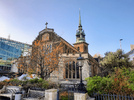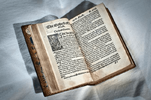Phil D.
ὁ βαπτιστὴς

All Hallows by the Tower is one of the oldest churches in London, with some architectural elements surviving from the 600s. It was one of the few churches in the city that survived the
great fire of 1666, which started only a few blocks away but was wind-driven in the opposite direction. The church became well-known as a place of temporary interment for many victims
of the public gallows on nearby Tower Hill. All Hallows also has some interesting historical connections with America: William Penn, founder of Pennsylvania, was baptized here in 1644,
and John Quincy Adams, the 6th president of the United States, married his British bride, Louisa, in All Hallows (1797).
When my wife and I had the privilege of traveling to London some years ago, we were able to visit a number of churches that had some fascinating links to church history. One of those was All Hallows by the Tower, the home church of a largely forgotten hero of the Reformation, Humphrey Monmouth.
Monmouth was a wealthy cloth merchant with a reputation for generously helping the less fortunate within his parish. Of much lesser renown, Monmouth was also part of a clandestine church reform group simply called The Christian Brethren. In 1523, upon hearing that a like-minded churchman was lecturing across town at St. Dunstan in the West church, he went to scope out the young preacher, one William Tyndale. The two soon became fast friends, and a few months later Tyndale moved in as a tutor to Monmouth's household, located very near All Hallows church, which in turn was just adjacent to the Tower of London.
In the meantime, Tyndale had also boldly asked the Bishop of London, Cuthbert Tunstall, to sponsor a new translation of the Bible into English, but was flatly refused. Upon learning this Monmouth quite eagerly, though quietly assumed the role of being patron to Tyndale’s bold ambition. However, officials learned of Tyndale's private translation efforts several months later, and when they threatened to permanently end them, Monmouth quickly arranged for his friend's escape to the Continent.
Several years later Tyndale published his ground-breaking English New Testament in Germany. Upon learning of this, Monmouth convinced a friendly Dutch merchant to hide dozens of copies of this welcome work inside bales of cloth that Monmouth’s company regularly imported, thus smuggling the Scriptures back into England. This daring arrangement, terminating on the bustling Billingsgate docks but 200 yards from All Hallows, continued for several years.
Monmouth was eventually imprisoned in the Tower on suspicion of sponsoring Tyndale's "naughty" book, which was being publicly burned whenever discovered. But the respected merchant shrewdly pointed out to investigators that if his business were to languish on account of his confinement, then of course the Royal Treasury would suffer a corresponding loss in tax revenue - upon which he was soon released.
In his last will and testament Monmouth stated that his highest goal in life had simply been "to spread the Holy Word of Jesus." Although the exact location is unknown, Monmouth is buried somewhere in the churchyard at All Hallows.
A first edition Tyndall New Testament (1526) on display in the British Library - most likely smuggled into England by Humphrey Monmouth.
